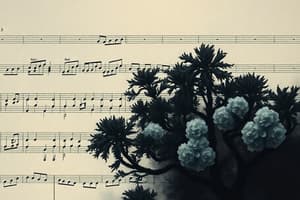Podcast
Questions and Answers
Müzik notasyonunda beş çizgi ve dört boşluk bulunan seti nedir?
Müzik notasyonunda beş çizgi ve dört boşluk bulunan seti nedir?
- Rest
- Staff (correct)
- Note
- Clef
Treble clef () ve Bass clef () nedir?
Treble clef () ve Bass clef () nedir?
- Nota değerlerinin belirtilmesi için kullanılan semboller
- Müzik notalarının sürelerinin belirtilmesi için kullanılan semboller
- Pitches'in yüksekliği ve alçaklığını belirten semboller (correct)
- Sessizliğin belirtilmesi için kullanılan semboller
Bir nota süresinin dört dakikaya eşit olan nota değeri nedir?
Bir nota süresinin dört dakikaya eşit olan nota değeri nedir?
- Half note
- Eighth note
- Quarter note
- Whole note (correct)
Müzikteki sessizlik süresini belirten sembollere nedir?
Müzikteki sessizlik süresini belirten sembollere nedir?
Üç notadan oluşan akoru nedir?
Üç notadan oluşan akoru nedir?
Müzikteki ritim ve ölçü birimini belirten sembol nedir?
Müzikteki ritim ve ölçü birimini belirten sembol nedir?
İki dakikaya eşit olan ölçü birimine nedir?
İki dakikaya eşit olan ölçü birimine nedir?
Ritmik desenlerinde yer değiştiren akörlerin kullanımına nedir?
Ritmik desenlerinde yer değiştiren akörlerin kullanımına nedir?
Flashcards are hidden until you start studying
Study Notes
Music Notation
- Staff: A set of five lines and four spaces where notes and other musical symbols are placed.
- Clefs: Symbols used to determine the pitch of notes. There are two main types:
- Treble clef (): Indicates higher pitches.
- Bass clef (): Indicates lower pitches.
- Note values: Symbols used to represent the duration of notes:
- Whole note: Four beats.
- Half note: Two beats.
- Quarter note: One beat.
- Eighth note: Half a beat.
- Sixteenth note: A quarter of a beat.
- Rests: Symbols used to indicate silence:
- Whole rest: Four beats of silence.
- Half rest: Two beats of silence.
- Quarter rest: One beat of silence.
- Eighth rest: Half a beat of silence.
- Sixteenth rest: A quarter of a beat of silence.
Chords
- Triad: A chord consisting of three notes: the root, third, and fifth.
- Chord types: Major, minor, augmented, and diminished.
- Chord progressions: A series of chords used to harmonize a piece of music.
- Chord notation: A way to notate chords using letters and symbols:
- Root note: The base note of the chord.
- Sharp (#) or flat (b) symbols indicate alterations to the root note.
- Major (maj) or minor (min) symbols indicate the chord type.
Rhythm
- Time signature: A symbol used to indicate the rhythm and meter of a piece:
- Numerator: The top number indicates how many beats are in a measure.
- Denominator: The bottom number indicates the type of note that gets one beat.
- Meter: The organization of rhythmic patterns into groups of strong and weak beats:
- Duple meter: A rhythm with two beats in a measure.
- Triple meter: A rhythm with three beats in a measure.
- Quadruple meter: A rhythm with four beats in a measure.
- Syncopation: The accentuation of off-beat rhythms to create a sense of tension or surprise.
Müzik Notasyonu
- Staff: Beş çizgi ve dört boşluğun birlikte notası ve diğer müzik simgelerinin yer aldığı bir set.
- Klef: Notaların perdesini belirlemek için kullanılan simgeler. İki ana türü vardır:
- Treble clef (): Yüksek perdeleri belirtir.
- Bass clef (): Düşük perdeleri belirtir.
Not Değerleri
- Dört çeyrek nota: Dört vuruşluk bir nota.
- İki çeyrek nota: İki vuruşluk bir nota.
- Çeyrek nota: Bir vuruşluk bir nota.
- Sekizinci nota: Yarım vuruşluk bir nota.
- On altıncı nota: Çeyrek vuruşluk bir nota.
Dinlenme
- Dört çeyrek dinlenme: Dört vuruşluk bir sessizlik.
- İki çeyrek dinlenme: İki vuruşluk bir sessizlik.
- Çeyrek dinlenme: Bir vuruşluk bir sessizlik.
- Sekizinci dinlenme: Yarım vuruşluk bir sessizlik.
- On altıncı dinlenme: Çeyrek vuruşluk bir sessizlik.
Akorlar
- Üçlü akor: Üç notadan oluşan bir akor: kök, üçüncü ve beşinci.
- Akor türleri: Major, minor,增mented ve diminished.
- Akor ilerlemeleri: Bir müzik parçası için kullanılan akor serileri.
- Akor notasyonu: Akorları notayla göstermek için kullanılan bir yöntem:
- Kök nota: Akorun temel notası.
- Diyez (#) veya bemol (b) simgeleri kök notanın değiştirilmesini belirtir.
- Major (maj) veya minor (min) simgeleri akor türünü belirtir.
Ritim
- Zaman imi: Bir müzik parçasının ritim ve ölçüsünü belirtmek için kullanılan bir simge:
- Sayısal: Üstteki sayı bir ölçünün kaç vuruşta olduğunu belirtir.
- Adi: Altteki sayı bir notanın bir vuruşta olduğunu belirtir.
- Ölçü: Ritim desenlerinin güçlü ve zayıf vuruşlar halinde gruplanmasına.
- İkili ölç: İki vuruşlu bir ölçü.
- Üçlü ölç: Üç vuruşlu bir ölçü.
- Dörtü ölç: Dört vuruşlu bir ölçü.
- Senkopasyon: Tansiyon veya sürpriz yaratmak için ölçünün dışındaki vuruşların vurgulanması.
Studying That Suits You
Use AI to generate personalized quizzes and flashcards to suit your learning preferences.




